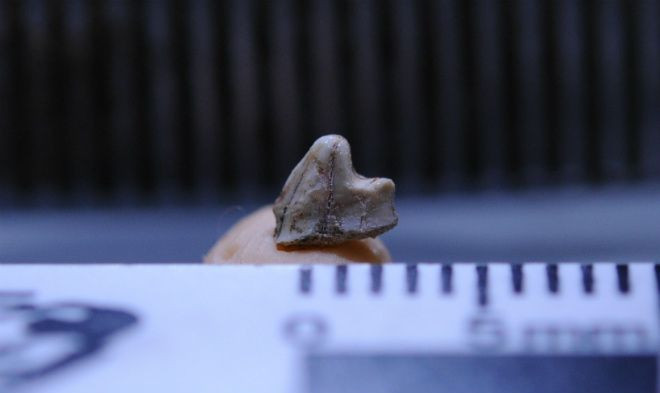Oldest Mammal Known From Brazil Named In Tribute To David Bowie

In December 2015, a broken tooth — a lower premolar, to be precise — was found in fossilized form in the São Paulo state of Brazil, and after two-and-a-half years of analyses, researchers announced it belonged to the oldest known mammal species from the country. They named the species Brasilestes stardusti, as a tribute to musician David Bowie, who died a month after the tooth’s discovery.
The fossil is only 3.5 millimeters (just over a tenth of an inch) in size, and the tooth’s roots are missing. It was found on a rocky outcrop in a field when one of the researchers spotted it sticking out. The rock was from the Mesozoic Era, which makes B. stardusti the only known mammal from Brazil that lived at the same time as the dinosaurs, between 87 million and 70 million years ago. And insofar as mammals went at the time, it was larger than most of its contemporaries.
“Although it’s only 3.5 mm, the Brasilestes tooth is three times bigger than all known Mesozoic mammal teeth. In the age of the dinosaurs, most mammals were the size of mice. Brasilestes was far larger, about the size of an opossum,” Mariela Cordeiro de Castro, paleontologist and a professor at the Federal University of Goiás in Brazil, and first author of a paper describing the tooth, said in a statement Monday.
Teeth are the most durable piece of mammals’ skeletons and are often found as fossils, and therefore, researchers have found ways to tell a lot about their owners even if they have only a small part to work with, as in the case of B. stardusti.
It belonged to a subclass of mammals called therian that includes both marsupials and placentals. The single tooth isn’t enough to identify with confidence the group B. stardusti belonged to but the researchers think it was likely a placental mammal. If so, it would be the only Mesozoic mammal of its kind known from South America. Other Mesozoic mammals that have previously been found on the continent were all in Argentina, at its southern tip.
The creature known to be most similar to B. stardusti, with similar premolars, is called Deccanolestes hislopi, and it lived all the way across the planet, in India, between 70 million and 66 million years ago.
“The discovery of Brasilestes raises many more questions than answers about the biogeography of South American Mesozoic mammals. Thanks to Brasilestes, we’ve realized that the history of Gondwana’s mammals is more complex than we thought,” Max Langer, a professor at the University of São Paulo and leader of the research team, said in the statement. Gondwana was an ancient supercontinent that broke up to become what are today Africa, Antarctica, Australia, India and South America.
Castro, whose primary research interest is the evolutionary history of xenarthrans — the order that includes anteaters, armadillos and sloths — said it was possible B. stardusti was an ancient xenarthran, based on the thin enamel on the tooth. But given the lack of more evidence, she wasn’t making any conclusions.
The study was funded by the São Paulo Research Foundation, a public institution in Brazil that supports scientific research in all fields of knowledge. The open-access paper, titled “A Late Cretaceous mammal from Brazil and the first radioisotopic age for the Bauru Group,” was published May 30 in the journal Royal Society Open Science.
© Copyright IBTimes 2024. All rights reserved.





















